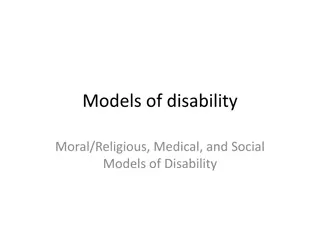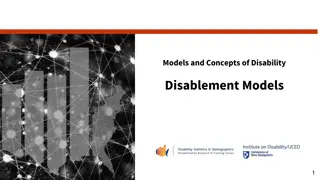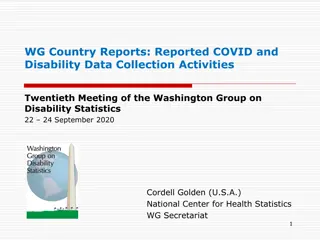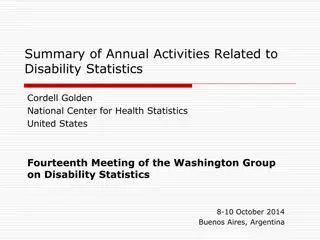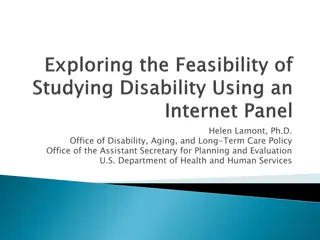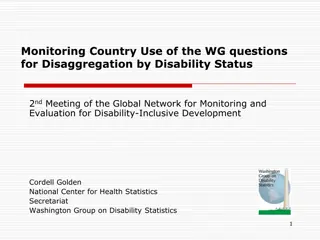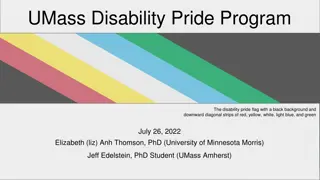Models and Concepts of Disability: Understanding the Disability Process and Components
Exploring various models and concepts of disability, this content delves into the disability process, including definitions, components, and interactions outlined by Nagi, IOM, and the ICF model. It highlights the perspective that disability is not inherent to the individual and can be preventable and reversible with proper rehabilitation. The four components of the disabling process – pathology, impairment, functional limitation, and disability – are discussed, providing insight into how these elements intersect and influence one's ability to perform expected roles and tasks in society.
Download Presentation

Please find below an Image/Link to download the presentation.
The content on the website is provided AS IS for your information and personal use only. It may not be sold, licensed, or shared on other websites without obtaining consent from the author. Download presentation by click this link. If you encounter any issues during the download, it is possible that the publisher has removed the file from their server.
E N D
Presentation Transcript
Models and Concepts of Disability Disability in America
Agenda Definitions of the Components of the Disability Process Modified IOM Model and its components The ICF Model Concepts, Use, Structure, Definitions The ICF Model Interaction between Components Summary
Revisiting the Disability Process According to Nagi (1965), disability is a limitation in performing certain roles and tasks that society expects of an individual [3] Disability is not inherent to the individual [3] Many disabling conditions are thus preventable and reversible with proper rehabilitation [3]
Revisiting the Disability Process The four components of the disabling process pathology, impairment, functional limitation and disability [3] These components were introduced by Nagi (1965) and later refined by IOM (1991)
TABLE 1 : Concepts of Pathology, Impairment, Functional Limitation, and Disability (IOM, 1991) [1] Pathology Impairment Functional Limitation Disability Definition Interruption or Loss and/or Lack Inability in interference of abnormality of of ability to performing socially normal bodily mental, emotional, perform an action defined activities processes or physiological, or or activity in the and roles expected structures anatomical structure manner considered of individuals or normal within a social and function: that results from physical includes all losses or impairment environment abnormalities;
TABLE 1 : Concepts of Pathology, Impairment, Functional Limitation, and Disability (IOM, 1991) Pathology Impairment Functional Limitation Disability Level of Reference Cells and tissues Organs and organ Organism action or Society systems activity task performance performance within the social and cultural context Example Denervated muscle Atrophy of muscle Cannot pull with Change of job; can in arm arm no longer swim due to trauma recreationally
Figure 2: The Enabling-Disabling Process [1] Environmental Modification Ramps; Universal Design Enlarge the environment to make it more accessible The Environment (Physical and Social) Disabling Process Enabling Process Person s needs grow relative to existing environment Functional Restoration Neural Repair; Range of motion; Artificial hip replacement Restore a person s functionality
Figure 1. The Modified IOM Model. The Disability in America Model (IOM 1991) [6] Transitional factors Biology Lifestyle and Behavior Environ -ment No Disabling Condition Functional Limitation Pathology Impairment Quality of Life
International Classification of Functioning, Disability, and Health (ICF) The ICF belongs to the WHO family of international classification [5] Collecting data about levels of functioning and disability is fundamental to predict service needs, length of hospitalization and level of care or functional outcomes [5]
International Classification of Functioning, Disability, and Health (ICF) The ICF framework helps collect disability data that is consistent and internationally comparable [5] ICF classifies functioning and disability associated with health conditions, NOT the people, themselves [5]
Why use the ICF? ICF is the world standard for conceptualizing and classifying functioning and disability, agreed by the World Health Assembly in 2001 [5] It provides a common language, terms and concepts on disability It is a multi purpose tool which allows for a wide range of use cases
Why use the ICF? ICF supports rights-based policies and provides a model to assist planning and communication across many sectors It provides an organized data structure for policy-relevant population data
ICF : Concepts of Functioning and Disability ICF is a framework to organize and document information on functioning and disability [5] ICF provides a standard language for disability by combining the medical and the social model of disability as a bio-psycho-social synthesis [5]
ICF: Concepts of functionality and disability ICF defines functioning as a dynamic interaction between a person s health condition, environmental factors and personal factors. [5] ICF uses a neutral language to record both positive and negative aspects of functioning [5]
Definitions of Components Functioning is an umbrella term for body functions, structures, activities and participation [5] Disability is an umbrella term for impairments, activity limitations and participation restrictions i.e. union of these three concepts [5] Body functions physiological functions of body systems [5] Body structures anatomical parts of the body e.g. limbs [5]
Definitions of Components Activities the execution of a task by an individual [5] Participation involvement in a life situation [5] Environmental factors physical, social, attitudinal environment in which a person lives [5]
The ICF Model: Interaction between ICF components Health Conditions (disorder or disease) Body Functions and Structures Participation Activities Environmental Factors Personal Factors
The ICF Model: An Example Osteoarthritis Body Functions and Structures Pain Range of Motion Muscle weakness Coordination deficits Problems with energy and drive Activities Mobility, standing, walking, use of transportation Grasping, handling of objects Participation Vocational performance Family relations Recreation and leisure Social life Personal Factors Health Behavior Coping strategies Age and Gender Environmental Factors Workplace Housing and transportation Facilities
Structure of the ICF Coding System ICF Part 1: Functioning and Disability Part 2: Contextual Factors Body Functions and Structures Activities and Participation Environment al Factors Personal Factors Facilitator/B arrier Change in Body Function Change in Body Structure Capacity Performance Item Levels- Item Levels- Item Levels- Item Levels- Item Levels- Domains and Categories at different levels 1st 2nd 3rd 1st 2nd 3rd 1st 2nd 3rd 1st 2nd 3rd 1st 2nd 3rd 19
The Importance of Definitions of Disability A single definition of disability does not meet societal needs. [2] The medical model made disability a lonely state defined and stigmatized by others. [2] The social model held that problems lie not within the person with disabilities but in the environment that fails to accommodate the people with disabilities. [2] For setting health policies in US, a framework like ICF, incorporating both social and medical perspective, is used. [2]
Anderson (1968): Social Determinants of Health Uses a three-stage model including predisposing, enabling and need components to explain the differing use of medical care services. [7] The initial unit of analysis was a family; Later it was changed to an individual. The initial behavior model is shown in the next slide.
Andersen (1968): Individual Determinants of Health Services Utilization Enabling Resources Predisposing Characteristics Illness Level Perceived Disability Symptoms Diagnosis Demographic Age Sex Personal/Family Income Health Insurance Type/Access to regular source Social Structure Education Race Occupation Evaluated Symptoms Diagnoses Community Price of health services Region of country Health Beliefs Values/Attitudes/Kno wledge about health, health services, diseases 22
Summary IOM model The ICF framework helps collect disability data The state of disability does not appear in this model since that is consistent and it is not inherent in the internationally comparable individual classifies functioning and disability associated with The no disabling condition indicates that complete health conditions, NOT the rehabilitation is possible people, themselves.
References Institute of Medicine (US) Committee on Assessing Rehabilitation Science and Engineering, Brandt, E. N., Jr., & Pope, A. M. (Eds.). (1997). Enabling America: Assessing the Role of Rehabilitation Science and Engineering. National Academies Press (US).[1] Iezzoni LI, Freedman VA. (2008). Turning the Disability Tide: The Importance of Definitions. JAMA, 299(3):332 334. doi:10.1001/jama.299.3.332.[2] Nagi, S. (1965). Some conceptual issues in disability and rehabilitation. In M. Sussman (Ed.), Sociology and Rehabilitation (pp. 100 113). Washington, DC: American Sociological Association. [3] Institute of Medicine (US) and National Research Council (US) Committee to Review the Social Security Administration's Disability Decision Process Research, Mathiowetz, N., & Wunderlich, G. S. (Eds.). (2000). Survey Measurement of Work Disability: Summary of a Workshop. National Academies Press (US).[4] International Classification of Functioning, Disability and Health (ICF). (n.d.). World Health Organization. Retrieved August 26, 2020, from http://www.who.int/classifications/icf/en/.[5] Institute of Medicine. (1991). Disability in America: Toward a National Agenda for Prevention. Washington, DC: The National Academies Press. https://doi.org/10.17226/1579. [6] Andersen, R. (1995). Revisiting the Behavioral Model and Access to Medical Care: Does it Matter? Journal of Health and Social Behavior,36(1), 1-10. Retrieved August 28, 2020, from http://www.jstor.org/stable/2137284. [7]



